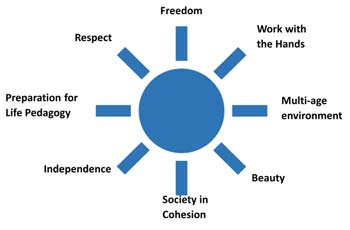The Essential Principles
What Are The Essential Principles? An Overview
The Montessori approach is a pedagogy based on the characteristics of children as they develop. According to Maria Montessori’s model of human development, all human children, regardless of culture, grow through 4 distinct planes of development. By designing an educational approach based on these qualities, Montessori education becomes a pedagogy that is centered on natural growth and development:
- First Plane: birth to age 6
- Second Plane: age 6 to 12
- Third Plane: age 12-18
- Fourth Plane: age 18-24
Essential Principles of Each Plane
Children at each plane share a set of characteristics and qualities, and each plane’s unique characteristics can be thought of in terms of essential principles. For example, children of the Second Plane are intensely social, and love to learn and work together. To expect these children to work alone ignores an important principle of their development at that stage.
Each plane thus has a small set of essential principles that should always be at the center of their learning environment.
Overarching Essential Principles for All Planes
In addition, there are overarching essential principles that span across all the planes of development and are fundamental to any Montessori environment. These principles require no special materials, and yet are extremely powerful for the inner growth of a child’s confidence, joy, and connection with others. The manifestation of the principles serves to uplift the whole child, whether in a Montessori environment with extensive or limited resources. It creates the potential for transformation.

Through my Montessori work in different cultures, I have focused on the following set of overarching essential principles as being foundational:
- Respect – among all members of the community, fostering trust, connection, dignity
- The Freedoms – to choose, to make mistakes, from unneeded help, to take time, to concentrate. Freedom with boundaries develops agency and self-control as well as a sense of safety.
- Multi-age Environment– fosters love, responsibility, connection, inspiration, community
- Work with the Hands – supports brain development, learning, re-regulation, and soothes the nervous system
- Preparation for Life – preparing for the world, learning skills and knowledge. Practical and academic preparation.
- Independence with Interdependence– Independence fosters self-confidence, motivation, courage. Interdependence fosters trust, humility, responsibility.
- Beauty – Self-expression as well as in the surroundings. Fostering creativity, joy, wonder, inspiration.
- Community – Fostering a sense of belonging and value, contribution. Strengthens traditions, culture, celebrations. Grace and courtesy and hospitality.
Many of these principles have been shown to be especially powerful for children coming from trauma or adversity. For example, Work with the Hands, especially rhythmic practical life movements as well as repetitive work with sensorial materials has been shown to soothe and re-regulate an agitated nervous system. Freedom to choose helps children regain a sense of control and agency over their life after perhaps experiencing trauma or acute stress. Being a contributing part of a community rebuilds a child’s sense of worth and value.
*For more about how Maria Montessori discovered the powerful effects of such work on traumatized children, please see The Best Weapon for Peace by Erica Moretti, and *articles on trauma-informed practice and Montessori by Bernadette Phillips.
A Few Things To Say about the Role of Montessori Materials
The emphasis here on essential principles does not in any way diminish the power and genius of the Montessori materials like the bead chains, the pink tower, the metal insets, the sandpaper letters, and all the rest. Montessori materials are beautifully polyvalent, serving as means for children to explore concepts concretely, master through self-correction, and learn through the work of their hands as the pathway to the brain. The Montessori materials help children learn and develop in a way that works with their innate desire to explore and touch and experiment and build.
When Montessori materials are available, this is of course ideal. But some environments may only have partial sets of materials. This is why the essential principles must be solidly present first.
The Montessori materials alone do not make a transformative environment. But if the essential principles are firmly rooted, then the inner work of growth and development can be supported while materials can be adapted and created according to the available resources in any context.
*Phillips, Bernadette et al. “Montessori, the White Cross, and Trauma-Informed Practice: Lessons for Contemporary Education” Journal of Montessori Research. Vol. 8, Issue 1, Spring 2022
